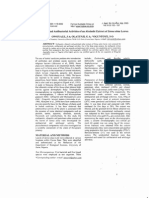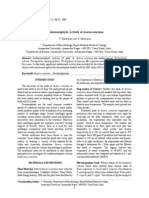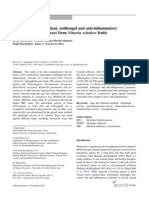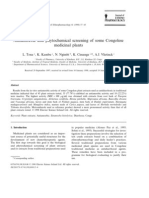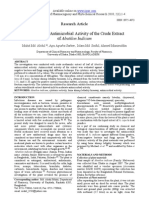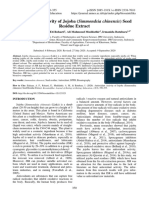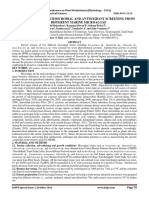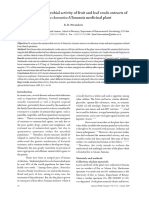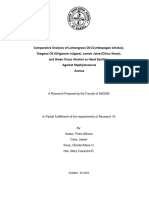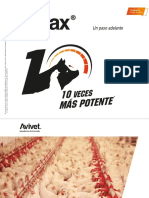Silymarin Natural Antimicrobiol Agent Extracted From Silybum Marianum
Silymarin Natural Antimicrobiol Agent Extracted From Silybum Marianum
Uploaded by
Joha Castillo JaramilloCopyright:
Available Formats
Silymarin Natural Antimicrobiol Agent Extracted From Silybum Marianum
Silymarin Natural Antimicrobiol Agent Extracted From Silybum Marianum
Uploaded by
Joha Castillo JaramilloOriginal Description:
Original Title
Copyright
Available Formats
Share this document
Did you find this document useful?
Is this content inappropriate?
Copyright:
Available Formats
Silymarin Natural Antimicrobiol Agent Extracted From Silybum Marianum
Silymarin Natural Antimicrobiol Agent Extracted From Silybum Marianum
Uploaded by
Joha Castillo JaramilloCopyright:
Available Formats
Lahlah et al.
164
Journal Academica Vol. 2(3), pp. 164-169, December 31 2012 - Microbiology - ISSN 2161-3338
online edition www.journalacademica.org 2012 Journal Academica Foundation
Full Length Research Paper
Silymarin Natural Antimicrobiol Agent Extracted from Silybum Marianum
Zohra F. Lahlah*, Meriem Meziani, Aicha Maza
Laboratory of Genius Microbiologic and Applications, Biology and Environment,
Faculty of Natural- and Life Sciences, University Mentouri, Constantine (Algeria)
Accepted December 22 2012
ABSTRACT
The goal of this work is the study and the valorisation of a medicinal plant Silybum marianum,
widely responded in Mediterranean region, particularly in Algeria. The chloroform and
butanolic solvents extracts of Silybum marianum were screened for antibiocidal and
phytochemical properties. Flavonoids were detected in both extracts. These extracts were active
against Staphylococcus aureus, Staphylococcus albus, Candida albicans and Saccharomyces
cerevisiea with a diameter exceeding (15mm). Flavonoides were separated and identified by a
thin layer chromatography (TLC) on silica gel. The TLC results allows to identify 3 different
spots S1, S2 and S3.The thermostability essays revealed their resistance at low (-5C, 4C) and
high temperatures (40C, 60C) during 30 min and inactivated at 100C. These results prove
antibiocidal effects of flavonoids extracted from silybum marianum, which enlarge the
therapeutic properties of this plant.
Key words: silymarin, flavonoids, antibiocidal activity, TLC, CMB/CMI
1. INTRODUCTION
Medicinal plants have been used for
centuries as remedies for human diseases
because they contain components of
therapeutic value (Nostro et al., 2000).
Flavonoids are a group of natural
compounds known to have various
pharmacological
actions
such
us
antioxydative, anti-inflammatory and
diuretic (Havsteen, 2002).
The development of resistance to the
available antibiotics has lead researchers
to investigate the antimicrobial activity of
medicinal plants. Silybum marianum
commonly called blessed milk thistle is a
small trees belonging to Asteracea family
with up to 1meter high, widely spread in
Mediterranean region notably in Algeria.
Flavonoids are naturally occurring
*
Corresponding author: fatia_zoh@yahoo.fr
substances
that
possess
various
pharmacological actions and therapeutic
applications. Some, due to their phenolic
structures, have antioxidant effect and
inhibit free-radical mediated processes
(Montvale; 2000).
The extracts of the flowers and leaves of
Silybum marianum (St. Marys thistle,
milk thistle) have been used for centuries
to treat liver, spleen, and gallbladder
disorders (Rainone, 2005). In the 1960s
the biologically active principles of the
seed and fruit extracts were isolated, and
the chemical structures were elucidated.
The isolation led first to a mixture that
was named Silymarin, and it was with
this flavonolignan mixture that most of
the clinical studies were carried out. The
main
constituents
are
Silibinin,
Lahlah et al. 165
Isosilibinin, Silicristin, and Silidianin
(Sonnenbichler and al., 1999).
One of the important issues about
Silymarin is that it may be accepted as a
safe herbal product, since no health
hazards or side effects are known in
conjunction
with
the
proper
administration of designed therapeutic
dosages (Montvale, 2000). In this study,
the chloroformic acetate of ethyl and
butanolic extracts of Silybum marianum
were investigated for antimicrobial and
antifungal activity. The phytochemical
components were also investigated as a
scientific assessment for the claim of
therapeutic potency.
The study aimed investigating the
antimicrobial activity of the plant by
preliminary in-vitro bioassay screening
using aqueous and petroleum ether as
well as chloroform extracts.
2. MATERIALS AND METHODS
2.1. Plant Material
Flowers of Silybum marianum were
collected and seeds than pulverized into
small coarse powder stored until required
for use.
2.2. Microorganisms
Microorganisms denoted with ATCC
included in this study (Staphylococcus
aureus,
Staphylococcus
albus,
Pseudomonas sp, Escherichia coli,
Serratia sp; Aspergillus sp, Penicillum
sp, Candida albicans and Saccharomyces
cereviseae) were provided from the
medical institute of microbiology
(Constantine;
Algeria).
The
microorganisms were maintained on
nutrient agar slants at 4C, reidentified by
biochemical tests and sub-cultured in
nutrient broth for 24h prior to testing.
2.3.Extraction and Fraction Procedure
Fractionation of the extracts was
fractionated using ethanol-water 80/20
v/v for 24h during three days and
different organic solvents (petroleumether, chloroform, acetate of ethyl and nbutanol). The powdered extract of the
plant 100g was overnight fractionated
with ethanol-water (800 ml) at room
temperature (Isaac and Chinwe, 2001).
The extract was filtered and then
partitioned into petroleum-ether than
chloroform, acetate of ethyl and
butanolic
solvents.
The
different
alcoholic extracts were evaporated in
Rotavapor
at
40-50C.
Finally
reconstituted in 6 ml of methanol as a
contributory antimicrobial effect of the
organic fractions. (Markham, 1982).
2.4. TLC Analysis
Merck silica gel plates Kieselgel F254
(Merck, Germany) and the following
mobile phases were used as eluent for
TLC:
S1:
toluene/butanol/ethanol/petroleum
ether 20/10/10/20 v/v.
S2: chloroform/acetone/formic acid
75/16,5/8,5 v/v.
S3: ethyl acetate /methanol/water
50/20/10 v/v.
The chromatogram was evaluated under
light after spraying the plate with godin
reagent (1% ethanolic solution of
vanillin, following by 3% of perchloric
acid solution).
2.5. Antimicrobial Assays
Pure culture of the organisms were
inoculated onto Muller-Hinton nutrient
broth (Oxoid, England), incubated for
24h at 37C. Diluted with sterile nutrient
broth to a density of 9108 cfu/ml
equivalent to McFarland test. The
suspension was used to streak for
confluent growth on the surface of
Muller-Hinton agar on Petri dishes with
sterile swab. Using a sterile 6mm disk
contained methanol as positive control.
The Petri dishes were placed in the
incubator overnight at 37C. The
Lahlah et al. 166
antimicrobial activity was recorded if the
zone of inhibition was greater than 9mm
(Hassan et al; 2006).
Antimicrobial activity was investigated
by the disk diffusion method and the
broth two fold macro dilution methods.
Results of the diffusion method were
expressed as the diameter of the
inhibition zone around the hole filled
with investigated solution.
Dilution method results were recorded as
the minimum inhibitory concentration
(MIC) and minimum microbiocidal
concentration (MMC). Details of both
methods are described else-where.
The determination of the minimum
inhibitory concentration MIC for butanol
and
chloroform
extracts
showed
significant activity (d > 9mm) and were
chosen for MIC assay. MIC was
determined by the standard method
(Kamagate and al; 2002) in there nutrient
broth was prepared and sterilized. 5 ml of
the prepared broth was dispensed in to
the test tubes.
Serial dilutions of plant extract
(chloroform
and
butanol)
were
undertaken to test the growth capacity of
the different microorganisms. 200 l of
each extract dilution were transferred into
each tube with exception of control tubes
and incubated 24-48 h at 37C.
2.6. Effect of Temperature
Chloroform and butanolic extracts were
treated at: 4C, 40C, 60C and 100C
during 30min. 100 l of the extracts were
added to suspension of nutrient broth and
Yeast extract glucose medium (YG)
inoculated by Staphylococcus albus and
Candida albicans. The suspension was
used to streak for confluent growth on the
surface of Muller-Hinton agar on Petri
dishes with sterile swab. Using a sterile
disk of 6mm diameter, tow disk
contained methanol were used as
reference or positive control. The Petri
dishes were placed in the incubator at
37C overnight.
2.7. Effect of Variation
400l of extract (chloroform, ethyl
acetate) were distributed in curved
Eppendorf tubes then dried by
evaporation and treated (NaOH/HCl)
1N/1N, fitted by means of a PH-meter to
the following PH values: 1.16; 3.01; 6.5;
8.6; 9.57; 11.9; 12.8; 13.15 and finally
left reacting for 30min.
3. RESULTS AND DISCUSSION
3.1. TLC
TLC was employed to determine the
composition of flavonoids in each
fraction. Flavonoids of S. marianum were
separated in three main fractions, which
were evaporated and redisoleved in 98%
methanol. The results lead to different
spots S1, S2, S3 with an RF (Rf1 =
0.36cm; Rf2 = 0.40cm; Rf3 = 0.53cm)
subsequently
corresponding
to
Silydianine, Silychristine, and Silybine,
the active constituent of Silymarine (Fig.
1).
Figure 1 TLC results of the different extracts (1:
chloroform; 2: ethyl acetate; 3: butanol).
3.1. Antimicrobial Results
98% methanol showed no inhibition
zones. Both flavonoid fractions inhibited
the growth of most of the microbial
strains tested. The only exceptions were
gram negatives and Mycelium fungi. The
Lahlah et al. 167
majority of yeasts were sensitive to both
flavonoids fractions. Candida albicans
and Saccharomyces cereviseae were the
only yeast inhibited by both extracts.
Among Mycelium fungi were resistant.
The size of all inhibition zones was
between 9 and 16mm for fungi. Average
size of inhibition zones was around
11mm for chloroform and ethyl acetate
fractions.
Bacteria most susceptible to both
fractions were gram-positive bacteria:
Staphylococcus
aureus,
and
Staphylococcus albus with a diameter of
17 and 18mm.
Table 1 Liquid dilution method results against S.
albus using chloroformic exacts.
Table 2 Liquid dilution method results against C.
albicans using chloroformic exacts.
3.2. MIC and CBM Results
98% methanol showed no inhibition
zones. Both flavonoid fractions inhibited
the growth of most of the microbial
strains tested. The only exceptions were
gram negatives and Mycelium fungi. The
majority of yeasts were sensitive to both
flavonoids fractions. Candida albicans
and Saccharomyces cereviseae were the
only yeast inhibited by both extracts,
however mycelium fungi were resistant.
Table 3 Results of CMI and CMB; CMI/CMB of
actives extracts against Staphylococcus albus and
Candida albicans.
The MIC of chloroform and butanolic
extracts ranged from 10, 25 - 20, 5 mg/ml
and 7- 14 mg/ml respectively (Table 3).
The chloroform extract has the lowest
MIC compared to butanolic extract.
The CMB of the extracts ranged from 41
and 28 mg/ ml respectively. The CMB /
CMI ratio ranged from 4 and 2 mg/ml
subsequently indicated a bacteriostatic
action of flavonoids (Archambaud,
2001).
The antimicrobial properties of this plant
probably explain its traditional use for
treating bacterial diseases. In 1996
Freiburghans indicate that different
solvent extracts of some plant may
exhibit pharmacological properties.
The mechanism of action of constituents
of S. marianum may be difficult to
speculate; however, many antibacterial
agents may exhibit their action through
inhibition of nucleic acid, protein and
membrane phospholipids biosynthesis
(Palanichamy et al., 1990). It is probable
that the antimicrobial agents in the
extracts act via some of the above cited
mechanisms. Further studies for in-vitro
activity,
isolation
and
structural
elucidation of the active components of
the plant extracts are recommended.
3.3. Effect of Temperature
Chloroform and butanolic extracts were
treated at: 4C; 40C; 60C; 100C
during 30min.
100l of the extracts were added to
suspension of nutrient broth and YG
inoculated by Staphylococcus albus and
Candida albicans.
Lahlah et al. 168
The suspension was used to streak for
confluent growth on the surface of
Muller-Hinton agar on Petri dishes with
sterile swab. Using a sterile disk of 6mm
diameter, tow disk contained methanol
were used as reference or positive
control. The Petri dishes were placed in
the incubator overnight at 37C. The
antimicrobial activity recorded if the
zone of inhibition was greater than 9mm
(Hassan et al; 2oo6).
Slightly until reach15 mm for the extract
of ethyl acetate (Laleh et al., 2006).
From9, 75 to 13, 16: the value of the
diameter of inhibition decreases until it
reaches the 10mm value for the extract of
chloroform and then increases. The PH
influences the activity of flavonoids by
substitution of the groupings (OH) which
surmount the structure three-dimensional
of these compounds what is confirmed by
the statistical study: Analysis of the
variance (ANOVA): Fobs > F 1, 14, 5%;
(6,68 >2, 4):
Figure 2 Inhibition of microbial growth via
butanolic and chloroformic extracts treated at
different temperatures.
These results indicate that flavonoids of
Silybum marianum conserves their
activity at moderate temperature [-5; 4;
40; 60C]; and inactivated at 100C, this
results
are
relatively
different
comparative at those obtained in 2006 by
Daughari. The optimum activity of
biological molecules was located at 40C
and 60C.
3.4. Effect of Ph Variation
According to the face (Fig. 3) three
intervals of Ph appear: from 1, 16 to 3,
01.
The value of the diameter of inhibition
increases slightly; it is situated between
10mm and 11mm for the extract of
chloroform, and of 15mm in 17mm for
ethyl acetate extract. From 3,01 to 9,75:
the diameter of inhibition increases and
remains relatively constant in value, it is
situated between 15mm and 16mm for
the chloroform extract and 9mm and
12mm for the ethyl acetate extract with a
decrease of diameter of inhibition.
Figure 3 Influence of PH variation.
4. CONCLUSION
Both flavonoid fractions inhibited the
growth of most of the microbial strains
tested: Gram-positive bacteria and Yeast.
The CMB/CMI ratio ranged from 2 and 4
mg/ml
subsequently
indicated
a
bacteriostatic action of flavonoids. TLC
results led to obtaining different spots S1,
S2, S3 with an RF of Rf1=0.36cm;
Rf2=0.40cm; Rf3=0.53cm subsequently
corresponding
to
Silydianine,
Silychristine and Silybine the active
constituent of Silymarine.
The optimum activity of biological
molecules was located at 40C and 60C
and at moderate Ph [6,5 - 8,5].
Lahlah et al. 169
REFERENCES
Archambaud. M. (2000). Evaluation
Methods of antibiotics activity. Brulures,
Vol.1.ed. Carr. Md.
Markham K.R. (1982). Techniques of
Flavonoids Identification. Academic
Press. London
Daughari. J. H. (2006). Antimicrobial
activity
of
Tamarindus
indica
Linn.Tropical Journal of pharmaceutical
research. Vol 5. Nom. 2 December:597603
Montvale, NJ. (2000). Milk Thistle
(Silybum marianum) in PDR for Herbal
Medicines
Medical
Economics
Company:516520
Hassan. S.W., Umar R.A., Lawal M.,
Biblis L.S., Muhammed B.Y., Dabai Y.U
(2006). Evaluation of antibacterial
activity and phyto chemical analysis of
root extracts of Boxia angustifolia.
African Journal of Biotechnology, 5.
(18):1602-07
Havesteen. (2002). The biochemistry and
medicinal
significance
of
the
flavonoids.Pharmacol. (96):67-202
Isaac and Chinwe. (2001). The
phytochemical analysis and antibacterial
screening of extracts of tetra carpidium
conophorum.J. chem.Soc.Nigeria 26
(1):53-55
Kamagate Kone D., Coulibaly N.T., Brou
E., Sixou M. (2001). Etude comparative
de diffrentes mthodes d'valuation de
la sensibilit aux antibiotiques. OrdontoStomatologie tropical. N95
Kaminsky R; Nkana MHN; Brun R.
(1996). Evaluation of African medicinal
plants for their in vitro trypanosidal
activity J. of Ethnopharmacol. 55:1-11
Laleh G.H; Frydoonfar H; Jameei R;
Zare S. (2006). The effect of light of
light, Temperature, PH and species on
stability of anthocyanins pigments in four
Berberi Species. J. Nutr. 5:90-92
Nostro A, Germano MP, D`angeloV,
Marino A, Cannatelli A. (2000). Exaction
methods
and
bioautography
for
evaluation of medicinal plant with
antimicrobial activity. Letters in appl.
Microbial. 30 (5):379
Palanichamy, S; Nagarajan S. (1990).
Antifungal activity of Cassia alata leaves
extracts. Ethanopharmacol. 29(3):337340
Rainone F. (2005). Milk thistle. Am
Family Physician. 2:1285
Sonnenbichler
J,
Scalera
F,
Sonnenbichler I, Weyhenmeyer R
(1999). Stimulatory Effects of silibinin
and silicristin from the milk thistle
Silybum marianum on kidney cells.
Pharmacol Exp. Ther. 290:1375
You might also like
- Antifungal Senna AlataDocument3 pagesAntifungal Senna AlatafannykinasihNo ratings yet
- Antimicrobial Activities of The Crude Methanol Extract of Acorus Calamus LinnDocument7 pagesAntimicrobial Activities of The Crude Methanol Extract of Acorus Calamus LinnClaudia Silvia TalalabNo ratings yet
- N Vitro Antimicrobial Activity of Muntingia CalaburaDocument5 pagesN Vitro Antimicrobial Activity of Muntingia CalaburaWahab RopekNo ratings yet
- 10Document5 pages10Xuân BaNo ratings yet
- Phytochemical Screening and Antimicrobial Activities Of: Terminalia Catappa, Leaf ExtractsDocument5 pagesPhytochemical Screening and Antimicrobial Activities Of: Terminalia Catappa, Leaf ExtractsOlapade BabatundeNo ratings yet
- Antioxidant, Antimicrobial Activity andDocument7 pagesAntioxidant, Antimicrobial Activity andDidi Haryo TistomoNo ratings yet
- Biological Investigations of Antioxidant-Antimicrobial Properties and Chemical Composition of Essential Oil From Lavandula MultifidaDocument6 pagesBiological Investigations of Antioxidant-Antimicrobial Properties and Chemical Composition of Essential Oil From Lavandula MultifidaladipupoNo ratings yet
- Antidermatophytic Activity of Acacia Concinna: V. Natarajan and S. NatarajanDocument2 pagesAntidermatophytic Activity of Acacia Concinna: V. Natarajan and S. NatarajanRajesh KumarNo ratings yet
- Materials and MethodsDocument8 pagesMaterials and MethodsVenkatesh BidkikarNo ratings yet
- Antimicrobial Activity and Phytochemical Screening of Stem Bark Extracts From (Linn)Document5 pagesAntimicrobial Activity and Phytochemical Screening of Stem Bark Extracts From (Linn)Rama DhanNo ratings yet
- Screening of Antibacterial Antituberculosis and Antifungal Effects of Lichen Usnea Florida and Its Thamnolic Acid ConstituentDocument6 pagesScreening of Antibacterial Antituberculosis and Antifungal Effects of Lichen Usnea Florida and Its Thamnolic Acid ConstituentJoe ScaliaNo ratings yet
- PDF 006984Document4 pagesPDF 006984Manan DesaiNo ratings yet
- Dilusi 3Document4 pagesDilusi 3IvanRizaMaulanaNo ratings yet
- tmp3741 TMPDocument8 pagestmp3741 TMPFrontiersNo ratings yet
- ICTROPS - Antimicrobial Activity and Phytochemical Properties of Actinodaphne Glomerata Leaves ExtractDocument4 pagesICTROPS - Antimicrobial Activity and Phytochemical Properties of Actinodaphne Glomerata Leaves ExtractJulinda manaluNo ratings yet
- Eurojournal 30 2 09Document5 pagesEurojournal 30 2 09Deamon SakaragaNo ratings yet
- Abjna 1 5 957 960Document4 pagesAbjna 1 5 957 960Fatima MalikNo ratings yet
- Esencijalna Ulja, EkstrakcijaDocument7 pagesEsencijalna Ulja, EkstrakcijaJelena MitrovicNo ratings yet
- Bio PesticideDocument8 pagesBio PesticideyasinNo ratings yet
- Antimicrobial Activity of Emilia Sonchifolia DC Tridax Procumbens Etc Potential As Food PreservativesDocument9 pagesAntimicrobial Activity of Emilia Sonchifolia DC Tridax Procumbens Etc Potential As Food Preservativessripathy84No ratings yet
- Antibacterial Effect of Carica Papaya Against Salmonella Typhi, Causative Agent of Typhoid FeverDocument4 pagesAntibacterial Effect of Carica Papaya Against Salmonella Typhi, Causative Agent of Typhoid FeverInternational Organization of Scientific Research (IOSR)No ratings yet
- Heloisa Et Al., 2013 Ethnobiol Cons (1) (1) 2idDocument8 pagesHeloisa Et Al., 2013 Ethnobiol Cons (1) (1) 2idpwlimaverdescribdNo ratings yet
- Antimicrobial Properties and Phytochemical Constituents of An Anti Diabetic Plant Gymnema MontanumDocument5 pagesAntimicrobial Properties and Phytochemical Constituents of An Anti Diabetic Plant Gymnema MontanumVanessa CautonNo ratings yet
- Antioxidant and Cytotoxic Effects of Methanol Extracts of AmorphophallusDocument4 pagesAntioxidant and Cytotoxic Effects of Methanol Extracts of AmorphophallusDidar SadiqNo ratings yet
- Antimicrobial Activities of Extracts and Flavonoid Glycosides of Corn Silk (Zea Mays L)Document7 pagesAntimicrobial Activities of Extracts and Flavonoid Glycosides of Corn Silk (Zea Mays L)ji jiNo ratings yet
- Anti Amoebic and Phytochemical Screening of Some Congolese Medicinal PlantsDocument9 pagesAnti Amoebic and Phytochemical Screening of Some Congolese Medicinal PlantsLuis A. CalderónNo ratings yet
- Phenolic Compounds of Chromolaena Odorata Protect Cultured Skin Cells From Oxidative Damage: Implication For Cutaneous Wound HealingDocument7 pagesPhenolic Compounds of Chromolaena Odorata Protect Cultured Skin Cells From Oxidative Damage: Implication For Cutaneous Wound HealingjampogaottNo ratings yet
- Phytochemical Analysis and Antimicrobial Screening of MoringaDocument4 pagesPhytochemical Analysis and Antimicrobial Screening of MoringanephylymNo ratings yet
- Önemli Mikrodalga StabiliteDocument7 pagesÖnemli Mikrodalga StabiliteSafa KaramanNo ratings yet
- Original Research Article: Lucida BenthDocument19 pagesOriginal Research Article: Lucida BenthmelendezjmanuelNo ratings yet
- 16Document9 pages16salutation82noblNo ratings yet
- 68596-Article Text-142595-1-10-20110804Document10 pages68596-Article Text-142595-1-10-20110804Aisha Mustapha FunmilayoNo ratings yet
- 1 SMDocument4 pages1 SMAbraham YirguNo ratings yet
- IMJM Vol14No1 Page 77-81 in Vitro Antibacterial Activity of Eurycoma Longifolia PDFDocument5 pagesIMJM Vol14No1 Page 77-81 in Vitro Antibacterial Activity of Eurycoma Longifolia PDFENjea LopiSma SPdieNo ratings yet
- Mythili International Research Journal of PharmacyDocument5 pagesMythili International Research Journal of PharmacymythiliNo ratings yet
- Chemrj 2017 02 03 133 143Document11 pagesChemrj 2017 02 03 133 143editor chemrjNo ratings yet
- Aloe VeraDocument0 pagesAloe VeraSyahrul FarhanahNo ratings yet
- ArticleDocument9 pagesArticleShahid IqbalNo ratings yet
- Luteolin, A Flavonoid From Syzygium Myrtifolium Walp.Document3 pagesLuteolin, A Flavonoid From Syzygium Myrtifolium Walp.Martinius TinNo ratings yet
- Antibacterial Activity of Chalcone and Dihydrochalcone Compounds From Uvaria Chamae Roots Against Multidrug-Resistant Bacteria.Document11 pagesAntibacterial Activity of Chalcone and Dihydrochalcone Compounds From Uvaria Chamae Roots Against Multidrug-Resistant Bacteria.shaniNo ratings yet
- Antibacterial Activity of Acalypha Indica LDocument4 pagesAntibacterial Activity of Acalypha Indica LMuhammad YusufNo ratings yet
- Ujmr 1 - 1 2016 - 009 PDFDocument11 pagesUjmr 1 - 1 2016 - 009 PDFBahauddeen SalisuNo ratings yet
- Cytotoxic and Antimicrobial Activity of The Crude Extract of Abutilon IndicumDocument4 pagesCytotoxic and Antimicrobial Activity of The Crude Extract of Abutilon IndicumApurba Sarker ApuNo ratings yet
- 045 ChongDocument8 pages045 ChongSandi Gusti AriyandaNo ratings yet
- Kháng khuẩn từ nước lá vốiDocument5 pagesKháng khuẩn từ nước lá vốiPhuong ThaoNo ratings yet
- In Vitro Antifungal Activity of The Soap Formulation ofDocument5 pagesIn Vitro Antifungal Activity of The Soap Formulation ofxiuhtlaltzinNo ratings yet
- Phytochemical and Antibacterial Evaluation of Various Extracts of Amoora Rohitukaa BarkDocument5 pagesPhytochemical and Antibacterial Evaluation of Various Extracts of Amoora Rohitukaa Barkumeshbt720No ratings yet
- Isolation Identification and Purification of Cinnamaldehyde From Cinnamomum Zeylanicum Bark Oil. An Antibacterial StudyDocument7 pagesIsolation Identification and Purification of Cinnamaldehyde From Cinnamomum Zeylanicum Bark Oil. An Antibacterial Studyrorido6673No ratings yet
- Ijtra 140820Document5 pagesIjtra 140820Akshay Kumar PandeyNo ratings yet
- Antioxidant Activity of Jojoba (Simmondsia Chinensis) Seed Residue ExtractDocument6 pagesAntioxidant Activity of Jojoba (Simmondsia Chinensis) Seed Residue Extract????? ??????No ratings yet
- Karabegoviü2011Document8 pagesKarabegoviü2011cinthyakaremNo ratings yet
- 10.prabakaran ManuscriptDocument5 pages10.prabakaran ManuscriptBaru Chandrasekhar RaoNo ratings yet
- Antibacterial and Antifungal Activities of Elephantopus Scaber LinnDocument8 pagesAntibacterial and Antifungal Activities of Elephantopus Scaber LinnyahyaNo ratings yet
- Jchpssi213nishanthirajencdrandas78 85 PDFDocument8 pagesJchpssi213nishanthirajencdrandas78 85 PDFhmossNo ratings yet
- Ajol File Journals - 45 - Articles - 7100 - Submission - Proof - 7100 529 50370 1 10 20090320Document6 pagesAjol File Journals - 45 - Articles - 7100 - Submission - Proof - 7100 529 50370 1 10 20090320abenapapabiplangeNo ratings yet
- In Vitro Studies of Antibacterial and CytotoxicityDocument5 pagesIn Vitro Studies of Antibacterial and CytotoxicityREMAN ALINGASANo ratings yet
- Biological Activities of The Fermentation Extract of The Endophytic Fungus Alternaria Alternata Isolated From Coffea Arabica LDocument13 pagesBiological Activities of The Fermentation Extract of The Endophytic Fungus Alternaria Alternata Isolated From Coffea Arabica LCece MarzamanNo ratings yet
- In Vitro Propagation and Secondary Metabolite Production from Medicinal Plants: Current Trends (Part 2)From EverandIn Vitro Propagation and Secondary Metabolite Production from Medicinal Plants: Current Trends (Part 2)No ratings yet
- Bioactives in Fruit: Health Benefits and Functional FoodsFrom EverandBioactives in Fruit: Health Benefits and Functional FoodsMargot SkinnerNo ratings yet
- Biocide Effect of Praepagen HY EngDocument8 pagesBiocide Effect of Praepagen HY EngNikolay PetrikevichNo ratings yet
- WHO NetDocument50 pagesWHO Nettummalapalli venkateswara raoNo ratings yet
- Antibacterial Activity of Metal Oxide NanoparticleDocument6 pagesAntibacterial Activity of Metal Oxide NanoparticleSandra ZitaNo ratings yet
- Pharmacology Brochure To DownloadDocument32 pagesPharmacology Brochure To DownloadAndrew George GeorgeNo ratings yet
- Microbiology Related Thesis TopicsDocument7 pagesMicrobiology Related Thesis Topicsjensantiagosyracuse100% (2)
- Phytochemical Screening Antioxidant and Antimicrobial Activities of Methanol Extract From Baphia Longipedicellata de WiDocument6 pagesPhytochemical Screening Antioxidant and Antimicrobial Activities of Methanol Extract From Baphia Longipedicellata de WiArmiyahu AlonigbejaNo ratings yet
- Comparative Analysis RESEARCH 3 HHHHDocument32 pagesComparative Analysis RESEARCH 3 HHHHgessNo ratings yet
- Worksheet No. 8 ASTDocument7 pagesWorksheet No. 8 ASTdominique sofitiaNo ratings yet
- Agar Well Diffusion MTDDocument7 pagesAgar Well Diffusion MTDRoland GealonNo ratings yet
- Microbiology Paper-1 QBDocument38 pagesMicrobiology Paper-1 QBPrem KumarNo ratings yet
- 7.2 Laboratory Methods For Antimicrobial Susceptibility TestingDocument5 pages7.2 Laboratory Methods For Antimicrobial Susceptibility TestingprincessNo ratings yet
- Antipneumococcal Activity of Ciprofloxacin, Ofloxacin, and Temafloxacin in An Experimental Mouse Pneumonia Model at Various Stages of The DiseaseDocument7 pagesAntipneumococcal Activity of Ciprofloxacin, Ofloxacin, and Temafloxacin in An Experimental Mouse Pneumonia Model at Various Stages of The Diseasecirus33No ratings yet
- Gyawali 2014Document90 pagesGyawali 2014Monyet...No ratings yet
- European Committee On Antimicrobial Susceptibility TestingDocument9 pagesEuropean Committee On Antimicrobial Susceptibility TestingGuneyden GuneydenNo ratings yet
- Bhawana Pandey Et AlDocument8 pagesBhawana Pandey Et AlhdjfhsjfhwjfNo ratings yet
- Antibiotic Stewardship in Critical Care: Ian Johnson MBCHB Frca and Victoria Banks Mbbs BSC Frca Fficm EdicDocument6 pagesAntibiotic Stewardship in Critical Care: Ian Johnson MBCHB Frca and Victoria Banks Mbbs BSC Frca Fficm EdicRavi KumarNo ratings yet
- Dental CareDocument9 pagesDental CareShahabas ShabuNo ratings yet
- Amirapaper-1Document10 pagesAmirapaper-1henriquesmacuveleNo ratings yet
- Diagnosis of Pulmonary Tuberculosis in Adults - UpToDateDocument31 pagesDiagnosis of Pulmonary Tuberculosis in Adults - UpToDatedixama9519No ratings yet
- Flucil: Product InformationDocument7 pagesFlucil: Product InformationaaNo ratings yet
- Antimicrobial Susceptibility Testing Using KirbyDocument5 pagesAntimicrobial Susceptibility Testing Using KirbyBlessie FernandezNo ratings yet
- Levofloxacin Loaded Microneedles Produced Using 3D Printed Molds For Noso InfectionDocument10 pagesLevofloxacin Loaded Microneedles Produced Using 3D Printed Molds For Noso Infectionyuvanshi jainNo ratings yet
- EJM - Volume 53 - Issue 1 - Pages 49-68Document20 pagesEJM - Volume 53 - Issue 1 - Pages 49-68seema yadavNo ratings yet
- Dokumen - Tips - Bpharm-7-Semester-Project-Reportfinal 2 PDFDocument25 pagesDokumen - Tips - Bpharm-7-Semester-Project-Reportfinal 2 PDFvishal sharmaNo ratings yet
- Tylvax PX 149Document36 pagesTylvax PX 149Artemio SanchezNo ratings yet
- Antimicrobial Susceptibility Testing (Antibiogram) : DR Alia Abdel MonaemDocument51 pagesAntimicrobial Susceptibility Testing (Antibiogram) : DR Alia Abdel MonaemAlia Abdelmonem100% (1)
- Botanical, Phytochemical and Pharmacological Review ofDocument4 pagesBotanical, Phytochemical and Pharmacological Review ofREMAN ALINGASANo ratings yet
- Chemical Composition and Inhibitory Effect of Essential Oil and Organic Extracts of Cestrum Nocturnum L. On Food-Borne PathogensDocument7 pagesChemical Composition and Inhibitory Effect of Essential Oil and Organic Extracts of Cestrum Nocturnum L. On Food-Borne PathogensAntonio OlivoNo ratings yet
- Mibs Learning OutcomesDocument22 pagesMibs Learning OutcomesthrrishaNo ratings yet
- Ceftriaxone For Injection, USP: Reference ID: 3446318Document4 pagesCeftriaxone For Injection, USP: Reference ID: 3446318devaldkNo ratings yet
